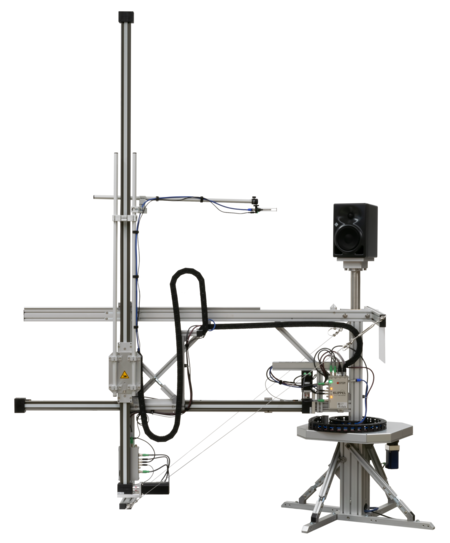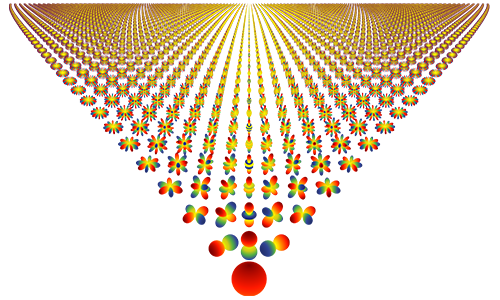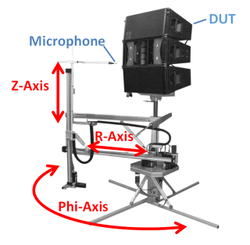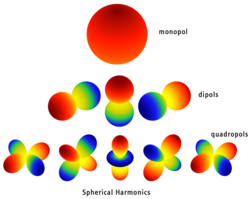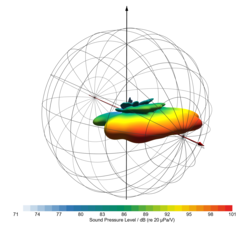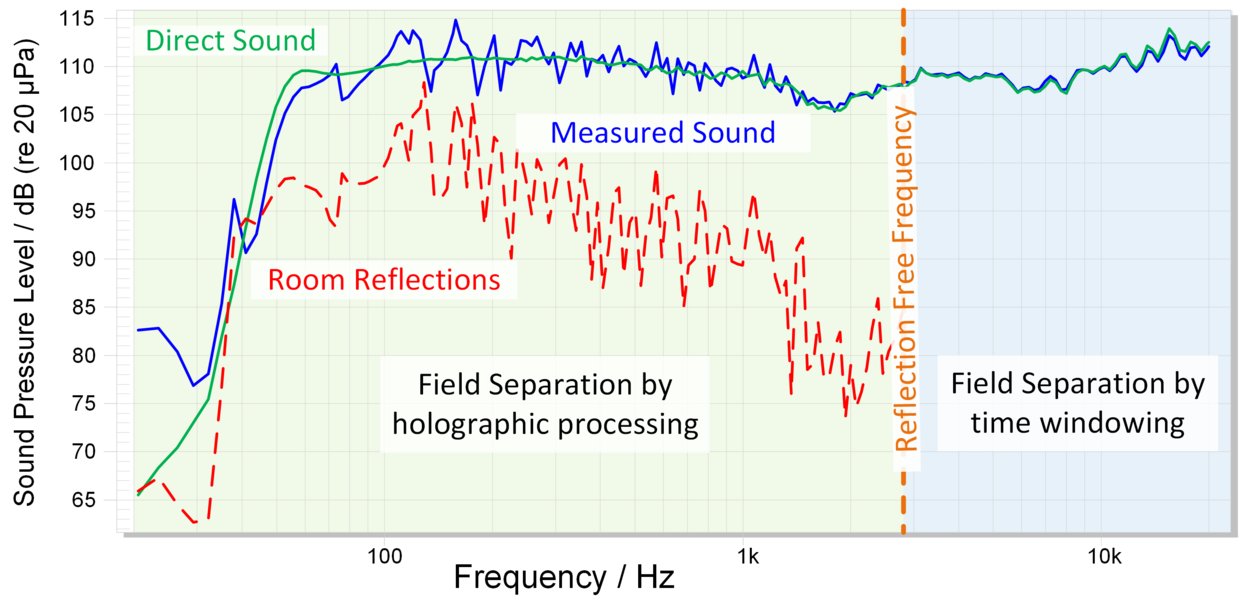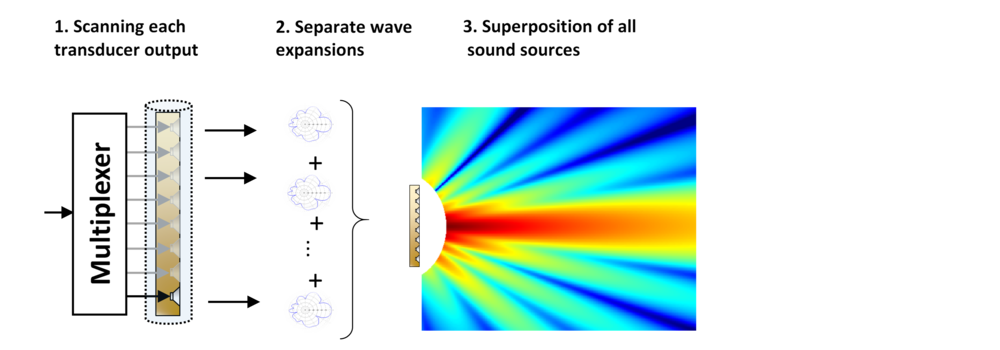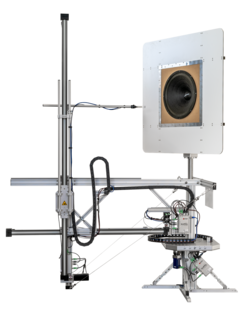Near Field Scanner System (NFS)
Features and Benefits
- SPL at any point in 3D space
- Directivity in near and far field
- High angular resolution
- Balloon / polar plot
- Power response
- Non-moving loudspeaker
- Open export interface
- Non-anechoic measurement
- Fast measurement
- Comprehensive radiation data set
- Portable measurement equipment
- Flexible dimensions
- Negligible reflections from equipment
- Applicable to large loudspeakers (500 kg)
The Near-Field-Scanner 3D (NFS) offers a fully automated acoustic measurement of direct sound radiated from the source under test. The radiated sound is determined in any desired distance and angle in the 3D space outside the scanning surface. Directivity, sound power, SPL response and many more key figures are obtained for any kind of loudspeaker and audio system in near field applications (e.g. studio monitors, mobile devices) as well as far field applications (e.g. professional audio systems). Utilizing a minimum of measurement points, a comprehensive data set is generated containing the loudspeaker's high resolution, free field sound radiation in the near and far field.
Specification
Demo Video
What's New in dB-Lab 212: Near Field Scanner 3D (NFS)
With loading this video, you agree that your data will be transferred to YouTube and that you have read our data protection policy.
Applicable to large loudspeakers
Due to non-moving loudspeaker, large Loudspeakers can be measured, being supported by a crane from ceiling.
Avoiding air diffraction problems for far field measurements
Far field measurements of large loudspeakers will require large anechoic chambers to ensure far field conditions. Such measurements suffer from diffraction problems caused by temperature differences in the air over distance and time, leading to high errors in the phase response in upper frequency bands. A temperature change of only 2°C will result in a phase error of 180 degree at 10kHz in 5m measurement distance.
No anechoic room needed
Radiated sound can be separated from reflected sound of the room by using field separation technique.
Higher accuracy than anechoic chamber measurement
No room correction curve needed below 100Hz.
Fast measurement
Standard 3D acoustic measurements like sound power are done in less than 20 minutes for typical 2-way systems.
High Signal-to-Noise-Ratio
High sound pressure level in near field. Less critical ambient noise requirements.
Comprehensive radiation data set
Radiation data set gained from near field measurement provides SPL at any point in 3D space.
Near and far field data is provided without the need of further measurements.
Provides full 3D Near Field Data
Near field data is provided at any point outside the scanned surface.
High angular resolution <1° with low number of points
Angular resolution is not depending on number of measurement points
(Traditional far field measurements require 64800 measurement points for 1° Resolution)
Measurement
The Near-Field Scanner 3D uses a moving microphone to scan the sound pressure in the near field of a compact sound source such as a loudspeaker system or a transducer mounted in a baffle. The device under test (< 500 kg) does not move during the scanning process. The reflections in the non-anechoic environment are then consistent and can be monitored with our novel analysis software, which uses acoustical holography and field separation techniques to extract the direct sound and to reduce room reflections.
Multi-pole Expansion
The sound field generated by the source is reconstructed by a weighted sum of spherical harmonics and Hankel functions which are solutions of the wave equation. The weighting coefficients in this expansion represent the unique information found in the near-field scan while gaining a significant data reduction.
Field Extrapolation
The near-field data, measured at a high SNR, is the basis for predicting the direct sound at larger distances. This avoids diffraction problems of classical far-field measurements (non-homogeneous media).
Performing a measurement in a small or reverberant room, the influence of the room cannot be neglected. Windowing techniques can be applied for high frequencies but not for low frequencies.
The Direct Sound Separation approach solves this issue, providing a separation of the radiated sound from the reflections and room resonances. This method is useful for low frequencies (below 1 kHz) where windowing techniques cannot be applied. In such frequency bands, even in well-built anechoic rooms, room modes build up.
The Near Field Analysis module provides the sound pressure at any point outside the scanning surface, which is required for assessing studio monitors, mobile phones and tablets as well as other personal audio devices, where the near field properties are important. At each position around the DUT, key features like complex transfer function, spatial sound pressure distribution (Magnitude + Phase) are visualized.
Data Export
Complex Data Export
The measurement data can be exported as complex frequency responses (Magnitude+Phase ) or impulse responses in common text and binary formats for external software like EASE-SpeakerLab, CLF, VACS, or other processing tools like MATLAB, SCILAB.
Holographic Parameter Export
In addition, the set holographic coefficients of the spherical wave expansion can exported as well in text or binary formats for MATLAB and SCILAB.
Asynchronous Measurement (wireless devices, Bluetooth®, Wi-Fi, open loop)
To measure audio devices that don’t have analog inputs, the stimulus can be transmitted using a wireless connection, or can be played as a wave file on the device itself. By using a 2nd microphone the variable delays are detected automatically. The impulse responses of the measurement microphone are synchronized to ensure accurate phase measurement.
The sound pressure output of loudspeaker systems with multiple transducers (line sources, sound bars, 3-way systems, etc.) can be determined by measuring each transducer separately using a multiplexer. After the holographic processing the sound pressure of the individual source can be superimposed to determine the total sound pressure output of the audio device.
Baffle that can be mounted on the NFS to perform half space the directivity measurements of transducers (up to 18”) and In wall speakers. By scanning on 2 hemi-spheres in front of the speaker, room reflection as well as diffraction effects from the baffle can be removed, providing accurate half space data.
Requirements
Hardware
• Near Field Scanner
• Klippel Analyzer 3
Module
• Transfer Function Measurement (TRF):
Measurement of transfer function and harmonic distortion
Accessories
• Microphone
• Power Amplifier
• Multiplexer (optional)
• PC
Related Information
Application Notes
Literature and Papers
- Klippel Near Field Scanner by Dave Logan
- Know-how Poster About Holographic Measurements
- Holographic Nearfield Measurement of Loudspeaker Directivity
- Holographic Nearfield Measurement of Loudspeaker Directivity (transparency)
- Holographic directivity measurement of line sources and sound panels (transparency)
Standards
Consumer Electronics Association
CEA-2034 (ANSI)
International Electrotechnical Commission
IEC 60268-5, IEC 60268-7, IEC 60268-21, IEC 62777, IEC WD 63034
Patents
Germany: 102013000684; US:9,584939B2; China: 2014100795121

